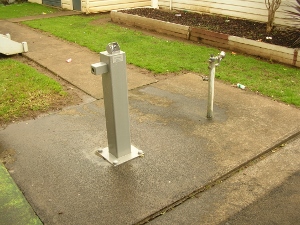
But risks do remain. Infected water might affect large numbers before the problem can be corrected and the consequences can be severe. The problem does not always lurk in the water supply itself but might be in outdated plumbing or even the playground fountains. Modern equipment will not only be more appealing to the students but quite possibly safer to drink from as well.
The Ministry of Health says many small rural communities do not have access to safe drinking-water and it offers a technical assistance programme to those affected. And while metropolitan water schools are likely to have better-quality supplies, problems can still arise. Ministry of Education guidelines point out that drinking poor-quality water can cause illness from poisoning or infection.
“Children are in the highest-risk group and in many cases can become ill without realising that it was the water that made them sick. Illness can result from exposure to protozoa (for example, Cryptosporidium and Giardia) and bacteria (for example, E. coli), or from lead poisoning.”
The Ministry states emphatically that as a condition of its Health and Safety Code of Practice, boards of trustees must ensure their schools have enough fresh water for drinking, washing and all other school purposes.
“Schools on town water supply only need to consider lead poisoning, as their water quality is controlled by local councils. Schools that are not on town supply and have their own supply of water (self-supplying schools) need to manage their water supply and comply with the drinking-water standards.” This affects around 500 schools in New Zealand.
Preventing lead poisoning
The Ministry regards lead poisoning as a significant risk that needs active prevention measures.
“Lead can appear in drinking water through the corrosion of brass in taps after water has been sitting in the plumbing overnight. All taps used for drinking should be flushed briefly before the start of school and around lunchtime. This is usually a task for your caretaker.
“Self-supplying schools should be aware that lead may also leach from roofs. Schools using a roof-water supply need to check with the local Health Protection Officer (HPO) to ensure their water supply has been tested for lead. If lead is a potential risk, the HPO can advise how to manage that risk.”
To control waterborne disease in New Zealand, the Ministry of Health introduced the Drinking-Water Standards for New Zealand 2005 (Revised 2008). Self-supplying schools must comply with the standards to meet their responsibilities to supply safe drinking water.
Section 10 of the Standard applies to self-supplying schools with small water supplies, serving fewer than 500 people. It requires schools to:
• use a Public Health Risk Management Plan-based compliance system that has been assessed as satisfactory by a drinking water assessor (an HPO specially trained to deal with drinking water issues)
• conduct an annual sanitary inspection, and
• monitor water quality for bacteria (E. coli) every three months.
“With training, the person responsible for the day-to-day running of the water treatment plant should be able to manage compliance with the standards, including producing the Risk Management Plan, the annual sanitary inspection and water testing. The school should not have to employ someone to carry out these tasks.”
Accessing outside help
Schools concerned about the quality of their drinking water will find no shortage of companies that can provide everything from bottled water to a wide range of purification equipment.
Mountain Fresh Ltd, for instance, has a range of domestic and commercial water purifiers available, also including UV sterilisation units, coolers and fountains
Director Grant McCarthy says he is trying to get schools to realise that even simple solutions about water can be very helpful to students. He says many schools have not spent any money on ensuring their drinking fountains are robust, user-friendly, or making the water nice to taste.
Mr McCarthy points out that teachers, as well as students, enjoy having fresh, filtered, cold water in staff rooms, “yet some our children are still drinking water out of old outdated drinking fountains that their parents used when they were at school.
“Dehydration reduces concentration and a child’s memory as well as making them lethargic and drowsy – even more so after lunch when they’ve been active on the fields and playgrounds. Often, children look at schoolyard drinking fountains as old and prehistoric with the taste and colour of some water being undesirable to drink. I don’t blame them for not wanting to drink this water,” Mr McCarthy said.
“Sugar and glucose-based drinks are brought to school but all these do is give our children a sweet dehydrating liquid to drink, not proper hydration.
If you google studies on not drinking enough water, you find concentration levels in children and their behaviour and general tiredness proves what most adults know. They need water and plenty of it.
“Drinking plenty of clean, fresh, filtered water helps with learning and remembering what you learnt. Most teachers are well aware of the importance of keeping their students hydrated. Isn’t it easier and more fulfilling for teachers to work with alert individuals that haven’t got to be reminded every five minutes about what they have just been taught?
“We spend large school budgets on computers and teaching aids, yet miss the boat on how our students brain functions when dehydrated. All the newest teaching techniques in the world will never change dehydrated children’s learning ability,” he said.
The much-delayed English draft curriculum is now out for consultation, generating discussion from teachers.
Research from AUT demonstrates arts, culture and recreation have positive impacts on all aspects of…
How effective has the school phone ban been in achieving its aims? Researchers from the…
School camps and excursions deliver hands on learning experiences, helping to consolidate classroom learning.
Innovations in AV technologies present new opportunities to engage with students. We look at how…
A new report from the University of Auckland’s Our Voices Project asks young people what…
This website uses cookies.